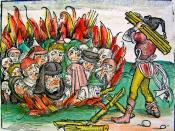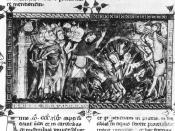Cantor states that,
No one - peasant or aristocrat - was safe from the disease [bubonic plague], and once it was contracted, a horrible and painful death was almost a certainty. The dead and the dying lay in the streets abandoned by frightened friends and relatives (482).
This certainly paints an accurate and horrifying picture of the fourteenth century during the plague. The bubonic plague, also known as the Black Death or The Plague, (Hindley 103) was one of the major scourges of the Middle Ages. It killed indiscriminately without remorse or thought of consequences. Because the plague was so widespread, theories about causes, blame and a variety of supposed cures abounded. Most of these were without basis or fact and relied on myths and rumors. Theories for the causes and blames came from ignorance and hate, two horrible things married by fear. Some of the cures were not much better than the plague itself.
The plague was transmitted to humans by fleas from infected rats that nested in people's roofs (Matthew 154). Fourteenth century man had no concept of how the disease was spread or how it could be stopped. The plague was transmitted to western Europe from China along trade routes (Matthew 154). Once the plague had reached the coast of Europe, it was soon transmitted to the countryside through the commercial trade networks (Matthew 154). The first cases of the plague occurred in a European colony called Genoa (Blum, Cameron and Barnes 38). It was 'besieged in 1347' by mongols, who flung plague riddled bodies over the walls of Genoa. This was considered 'an early form of biological warfare' (Blum, Cameron and Barnes 38). According to Matthews, 'Experts could do nothing to cure or explain the plague' (154). The people of this period had no idea what...



Good job
This is very good detail and description of the plague and what it did.
I like the fact that there was a lot of sources cited in the bibliography.
Good work.
0 out of 0 people found this comment useful.